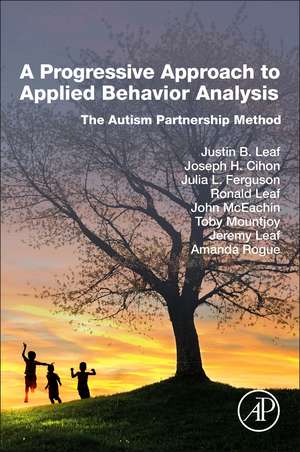A Progressive Approach to Applied Behavior Analysis: The Autism Partnership Method
Autor Justin B Leaf, Joseph H Cihon, Julia L Ferguson, Ronald Leaf, John Mceachin, Toby Mountjoy, Jeremy Leaf, Amanda Rogueen Limba Engleză Paperback – 21 sep 2023
- Summarizes Autism Partnership Method and Progressive ABA
- Explores how to use ABA for teaching and behavioral intervention
- Discusses reinforcement conditioning, punishment, and token economies
Preț: 701.15 lei
Preț vechi: 738.06 lei
-5% Nou
Puncte Express: 1052
Preț estimativ în valută:
134.16€ • 146.19$ • 113.05£
134.16€ • 146.19$ • 113.05£
Carte tipărită la comandă
Livrare economică 16-30 aprilie
Preluare comenzi: 021 569.72.76
Specificații
ISBN-13: 9780323957410
ISBN-10: 0323957412
Pagini: 402
Dimensiuni: 152 x 229 mm
Greutate: 0.54 kg
Editura: ELSEVIER SCIENCE
ISBN-10: 0323957412
Pagini: 402
Dimensiuni: 152 x 229 mm
Greutate: 0.54 kg
Editura: ELSEVIER SCIENCE
Cuprins
About the authors
1. Applied behavior analysis
What is ABA?
Some research examples
Recent events
Summary
References
2. An overview and history of the Autism Partnership Method
First tenet: Clinical judgment
Second tenet: Learner-centered
Third tenet: Meaningful and functional curriculum
Fourth tenet: Flexible procedures
Fifth tenet: Working with the whole family
Sixth tenet: Performance-based staff training
Seventh tenet: Compassion
The history of the APM
References
3. Respondent and operant behavior
Reflexes and respondent behavior
Operant behavior
Some important notes
Summary
References
4. Stimulus control and generalization
Generalization
Summary
References
5. Reinforcement: Overview, identification, conditioning
Reinforcer identification
Conditioning reinforcers
Summary
References
6. Punishment: Overview, concerns, and use
Some concerns with the use of punishment-based procedures
Clinical considerations
Some punishment-based procedures
Summary
References
7. Token economies and other contingency systems
Components of token systems
The commonality of token economies
Advantages and disadvantages of token systems
Some relevant research
Clinical recommendations and progressive approaches to token systems
Summary
References
8. Respondent conditioning procedures
Considerations related to respondent behavior in autism intervention
Summary
References
9. Task analysis and chaining
Task analysis
Chaining
Research
Summary
References
10. Shaping
A sample of research
Clinical recommendations
Summary
References
11. Prompting
Prompt types
Prompting systems
Flexible prompt fading: The APM prompting system
Summary
References
12. Discrete trial teaching
Components of DTT
Summary
References
13. Naturalistic instruction
Incidental teaching
Embedded instructions
Summary
References
14. The teaching interaction procedure
Overview
Teaching interaction procedure research
Summary
References
15. Cool versus Not Cool procedure
Steps of the CNC procedure
Misuses of the CNC procedure
History and research
Summary
References
16. Social skills groups
Hallmarks of behaviorally based social skills groups
Research
Summary
References
17. Functional behavior assessment and functional analysis
Overview of functional behavior assessment
Types of functional analysis
History of FBA and functional analysis
Autism partnership method to FBAs and FAs
References
18. Differential reinforcement
Differential reinforcement of other behavior
Differential reinforcement of alternative behavior
Differential reinforcement of incompatible behavior
Differential reinforcement of low rates of behavior and differential reinforcement of high rates of behavior
Some progressive considerations regarding differential reinforcement
Summary
References
19. Extinction and response cost
Misperceptions and clarifications related to extinction
Response cost
Misperceptions and clarifications related to response cost
Recommendations for practice
Summary
References
20. Time out from positive reinforcement and the time-in ribbon
Time-out from positive reinforcement
Research on time-out
Autism partnership method and time-out
Time-in ribbon
Summary
References
21. Measurement systems
Considerations in selecting a measurement system
Measurement systems
Measuring with our heart
Summary
References
22. Formal assessments
The assessments
Summary
References
23. Curriculum assessment
Common curriculum assessments
Autism Partnership Method and curricular assessment
Building the curriculum
References
24. Learning-how-to-learn curriculum
The skills
Summary
References
25. Social skills curriculum
Reasons why we teach social skills
Reasons why social skills development is often not a priority
What to teach: The social skills taxonomy
How to teach social behavior
Don’t forget
Summary
References
26. Language curriculum
Language programs
Summary
References
27. Self-help and adaptive behaviors
Toilet training
Mealtime challenges
Sleep
Appearance checks
Basic efficiency and organization
Walk with me
Crossing the street safely
Following a visual or written schedule
Self-advocacy
Summary
References
28. Working with parents of autistic children
Prediagnosis stress
Diagnostic process stress
Postdiagnosis stress
Intervention stress
Autism partnership method of parent support
Research on parent training
Summary
References
29. Siblings
Sibling relationship throughout the lifespan
The Autism Partnership Method and siblings
References
30. Staff and staff training
Characteristics of quality interventionists
Additional skills interventionists should display
Additional skills supervisors should display
Staff training
Summary
References
Index
